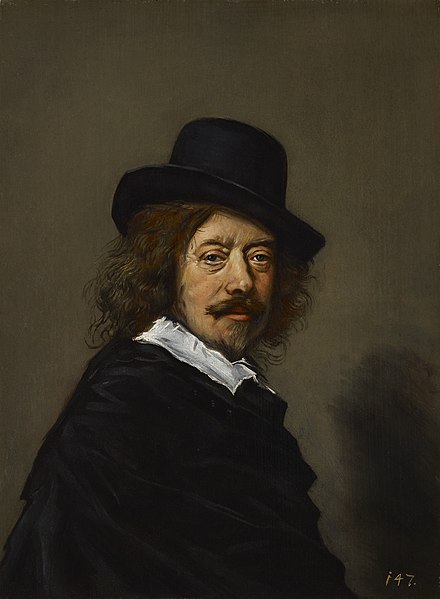
Born: c. 1582, Antwerp
Died: 26 August 1666 (aged 83-84)
Period: Dutch Baroque
The Life of Frans Hals
Frans Hals was a Dutch Golden Age painter known for his vivid and lively portraiture. Born either in Antwerp or Haarlem, he moved to Haarlem with his family as a child, fleeing from the Spanish siege of Antwerp. Haarlem, a city in the Dutch Republic, became the center of Hals’s life and career. He trained under the Flemish painter Karel van Mander, who is credited with introducing Hals to the energetic brushwork and keen observation of detail that would characterize his work.
Hals quickly established himself as a leading portraitist, capturing the burgeoning merchant and civic elite in Haarlem. Unlike many of his contemporaries, Hals rarely painted mythological or religious subjects, focusing instead on individual and group portraits. His work is noted for its exceptional vitality and nuanced depiction of human emotions, achieved through his loose, expressive brushwork and sophisticated use of light and shadow.
Among Hals’s most famous works are his series of civic guard portraits, which include dynamic group compositions full of individual character and liveliness unusual for the time. He also excelled in individual portraits, capturing his sitters with an immediacy and directness that make his paintings feel modern. His ability to depict fabrics and textures in a seemingly effortless manner added to the vibrancy of his portraits.
Despite his success, Hals experienced financial difficulties in later life, partly due to the economic decline of Haarlem and personal misfortunes. He continued to paint into his old age, with his later works characterized by an even looser brushwork and a greater emphasis on the emotional depth of his subjects.
Hals was largely forgotten after his death, but his work was rediscovered in the 19th century, influencing and inspiring many later artists, including Impressionists who admired his technique and approach to light and color. Today, Frans Hals is celebrated as one of the Dutch Golden Age’s foremost masters, revered for his lively, innovative portraiture that captures the essence of his subjects with unprecedented vitality.
Frans Hals’s Notable Works
Frans Hals, one of the leading Dutch portrait painters of the 17th century, is celebrated for his lively and spirited portrayal of subjects, ranging from the affluent citizens of Haarlem to the vivacious characters of local taverns. His work is distinguished by its vivid realism, expressive brushwork, and keen observation of human nature. Here are ten of Frans Hals’s most famous and influential works:
- The Laughing Cavalier (1624) – This iconic portrait is renowned for its subject’s engaging smile and the exquisite detail of his attire, showcasing Hals’s mastery in capturing personality and texture.
- The Banquet of the Officers of the St George Militia Company (1616) – One of several group portraits Hals painted of militia companies, this work is admired for its lively depiction of the officers and the dynamic composition.
- Shrovetide Revellers (c. 1616-1617) – Also known as “Merrymakers at Shrovetide,” this painting captures the boisterous spirit of a group enjoying the Shrovetide festival, highlighting Hals’s ability to depict joy and movement.
- The Gypsy Girl (1628-1630) – This captivating portrait, sometimes called “Malle Babbe,” shows a young woman with a captivating smile, exemplifying Hals’s skill in portraying expressive faces.
- Regents of the Old Men’s Alms House (1664) – One of his later works, this group portrait of the regents of a Haarlem almshouse is noted for its more sober and reflective quality, demonstrating Hals’s range in capturing human character.
- Regentesses of the Old Men’s Alms House (1664) – The female counterpart to the regents’ portrait, this painting similarly portrays the dignified and solemn nature of its subjects, with Hals’s characteristic attention to detail and texture.
- The Wedding of Peleus and Thetis (c. 1610) – Though primarily known for his portraits, this mythological scene stands out as an example of Hals’s early work and his ability to handle complex compositions and a multitude of figures.
- Portrait of Isaak Abrahamsz Massa (1626) – A friend of Hals, Massa is portrayed in a relaxed, informal manner, set against a lush, green landscape that adds depth and contrast to the composition.
- The Jolly Toper (c. 1628-1630) – This portrait of a jovial drinker, possibly a self-portrait or a depiction of a known personality from Haarlem, is celebrated for its vibrant expression of merriment and the fluidity of Hals’s brushwork.
- Portrait of René Descartes (1649) – Although some debate surrounds the attribution, this portrait of the French philosopher is often credited to Hals, showcasing a more subdued and introspective depiction in contrast to his more animated subjects.
Frans Hals’s work continues to be admired for its vitality, expressiveness, and innovative approach to portraiture, which breathed life and character into the genre and influenced future generations of artists.